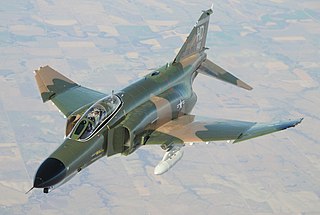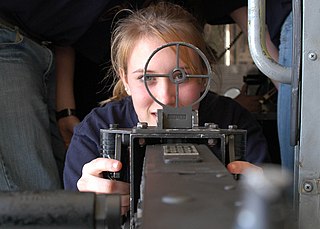
The Telescopic Sighting System (TESS) was a sight used on the FV4201 Chieftain tank [1] and RAF F-4 Phantom aircraft. [2]

The Telescopic Sighting System (TESS) was a sight used on the FV4201 Chieftain tank [1] and RAF F-4 Phantom aircraft. [2]
The TESS was trialed and introduced in the early 1980s originally as a tank sight for the FV4201 Chieftain. Surplus stocks were used on F-4 Phantom aircraft operated by the Royal Air Force as a cost-saving measure for a long range daytime target identification device, whereas the United States Air Force used the TISEO on their F-4 Phantoms. The TESS was installed in the rear cockpit in the centre window section for the Radar Intercept Officer to use. [3] It was boresighted to the aircraft weapons system and when locked on target, the target was magnified six times. [4]

The McDonnell Douglas F-4 Phantom II is an American tandem two-seat, twin-engine, all-weather, long-range supersonic jet interceptor and fighter-bomber that was developed by McDonnell Aircraft for the United States Navy. Proving highly adaptable, it entered service with the Navy in 1961 before it was adopted by the United States Marine Corps and the United States Air Force, and by the mid-1960s it had become a major part of their air arms. Phantom production ran from 1958 to 1981 with a total of 5,195 aircraft built, making it the most produced American supersonic military aircraft in history, and cementing its position as a signature combat aircraft of the Cold War.

The Eurofighter Typhoon is a European multinational twin-engine, supersonic, canard delta wing, multirole fighter. The Typhoon was designed originally as an air-superiority fighter and is manufactured by a consortium of Airbus, BAE Systems and Leonardo that conducts the majority of the project through a joint holding company, Eurofighter Jagdflugzeug GmbH. The NATO Eurofighter and Tornado Management Agency, representing the UK, Germany, Italy and Spain, manages the project and is the prime customer.

The SEPECAT Jaguar is an Anglo-French supersonic jet attack aircraft originally used by the British Royal Air Force and the French Air Force in the close air support and nuclear strike role. As of 2024, the Jaguar remains in service with the Indian Air Force.

A periscope is an instrument for observation over, around or through an object, obstacle or condition that prevents direct line-of-sight observation from an observer's current position.

The English Electric Lightning is a British fighter aircraft that served as an interceptor during the 1960s, the 1970s and into the late 1980s. It is capable of a top speed of above Mach 2. The Lightning was designed, developed, and manufactured by English Electric. After EE merged with other aircraft manufacturers to form the British Aircraft Corporation it was marketed as the BAC Lightning. It was operated by the Royal Air Force (RAF), the Kuwait Air Force (KAF), and the Royal Saudi Air Force (RSAF).

The Panavia Tornado Air Defence Variant (ADV) is a long-range, twin-engine swing-wing interceptor aircraft developed by the European Panavia Aircraft GmbH consortium. It was a specialised derivative of the multirole Panavia Tornado.

Operation Granby, commonly abbreviated Op Granby, was the code name given to the British military operations during the 1991 Gulf War. 53,462 members of the British Armed Forces were deployed during the conflict. Forty-seven British personnel were killed during Op Granby and many more were injured during the hostilities there. The total cost of operations was £2.434 billion (1992), of which at least £2.049 billion was paid for by other nations such as Kuwait and Saudi Arabia. £200 million of equipment was lost or written off.

Royal Air Force Coningsby or RAF Coningsby, is a Royal Air Force (RAF) station located 13.7 kilometres (8.5 mi) south-west of Horncastle, and 15.8 kilometres (9.8 mi) north-west of Boston, in the East Lindsey district of Lincolnshire, England. It is a Main Operating Base of the RAF and home to three front-line Eurofighter Typhoon FGR4 units, No. 3 Squadron, No. 11 Squadron and No. 12 Squadron. In support of front-line units, No. 29 Squadron is the Typhoon Operational Conversion Unit and No. 41 Squadron is the Typhoon Test and Evaluation Squadron. Coningsby is also the home of the Battle of Britain Memorial Flight (BBMF) which operates a variety of historic RAF aircraft.

Brimstone is a ground or air-launched ground attack missile developed by MBDA UK for the UK's Royal Air Force. It was originally intended for "fire-and-forget" use against mass formations of enemy armour, using a millimetre wave (mmW) active radar homing seeker to ensure accuracy even against moving targets. Experience in Afghanistan led to the addition of laser guidance in the dual-mode Brimstone missile, allowing a "spotter" to pick out specific and the highest priority targets, particularly useful to minimise collateral damage when friendly forces or civilians were in the area. The tandem shaped-charge warhead is much more effective against modern tanks than older similar weapons such as the AGM-65G Maverick missile. Three Brimstones are carried on a launcher that occupies a single weapon station, allowing a single aircraft to carry many missiles.

Royal Air Force Wattisham or more simply RAF Wattisham was, between 1939 and 1993, the name of a Royal Air Force station located in East Anglia just outside the village of Wattisham, south of Stowmarket in Suffolk, England. During the Cold War it was a major front-line air force base, operating Quick Reaction Alert (South), before closing as an Royal Air Force station in 1993. Since 1993 it has been operated by the British Army as Wattisham Flying Station.

The FV4201 Chieftain was the main battle tank (MBT) of the United Kingdom from the 1960s into 1990s. When introduced, it was among the most heavily armed MBTs of the era, mounting a 120 mm Royal Ordnance L11 gun, the equal of the much larger specialist heavy tanks then in service. It also was among the most heavily armoured, with up to 195 mm (7.7 in) that was highly sloped to offer 388 mm (15.3 in) thickness along the line of sight.

BL755 is a cluster bomb developed by Hunting Aircraft that contains 147 parachute-retarded high explosive anti-tank (HEAT) submunitions. Its primary targets are armoured vehicles and tanks with secondary soft target capabilities. It entered service with the Royal Air Force (RAF) in 1973.

A sight or sighting device is any device used to assist in precise visual alignment of weapons, surveying instruments, aircraft equipment, optical illumination equipment or larger optical instruments with the intended target. Sights can be a simple set or system of physical markers that serve as visual references for directly aligning the user's line of sight with the target, or optical instruments that provide an optically enhanced—often magnified—target image aligned in the same focus with an aiming point. There are also sights that actively project an illuminated point of aim onto the target itself so it can be observed by anyone with a direct view, such as laser sights and infrared illuminators on some night vision devices, as well as augmented or even virtual reality-enabled digital cameras with software algorithms that produce digitally enhanced target images.

Royal Air Force Woodbridge, or more simply RAF Woodbridge, is a former Royal Air Force station located east of Woodbridge and around 7 miles north-east of Ipswich, in the county of Suffolk, England.

Royal Air Force Station Wildenrath, commonly known as RAF Wildenrath, was a Royal Air Force (RAF) military airbase near Wildenrath in North Rhine-Westphalia, Germany, that operated from 1952 to 1992. Wildenrath was the first of four 'clutch' stations built for the Royal Air Force in West Germany during the early 1950s.

Number 56 Squadron, also known as No. 56 Test and Evaluation Squadron (TES), nicknamed the Firebirds for their ability to always reappear intact regardless of the odds, is one of the oldest and most successful squadrons of the Royal Air Force, with battle honours from many of the significant air campaigns of both the First and Second World Wars.

F-4 Phantom II non-U.S. operators are the non-U.S. nations with air forces that operate or used to operate the McDonnell Douglas F-4 Phantom II. The Phantom II entered service with the U.S. military in 1960 and served until 1996. During this time it was the primary interceptor, air superiority fighter and fighter bomber with the U.S. Navy, Marines and Air Force.

The United Kingdom (UK) operated the McDonnell Douglas F-4 Phantom II as one of its principal combat aircraft from 1968 to 1992. The UK was the first export customer for the F-4 Phantom, which was ordered in the context of political and economic difficulties around British designs for the roles that it eventually undertook. The Phantom was procured to serve in both the Royal Navy's Fleet Air Arm (FAA) and the Royal Air Force (RAF) in several roles including air defence, close air support, low-level attack and tactical reconnaissance.

A total of 185 F-4 Phantoms were produced and operated by the United Kingdom between 1968 and 1992. The Phantom replaced the de Havilland Sea Vixen in the Royal Navy fleet air defence role, and was initially procured to replace the Hawker Hunter in the close air support and tactical reconnaissance roles in the Royal Air Force. Subsequently, when replaced by the SEPECAT Jaguar for close air support and reconnaissance Phantoms replaced the English Electric Lightning interceptors. The Phantom was operated by the Royal Navy until 1978, when HMS Ark Royal, the only British ship capable of operating the aircraft, was decommissioned. Following this, the Royal Navy's Phantoms were turned over to the Royal Air Force. The Phantom began to be replaced by the Panavia Tornado ADV from 1987, and was finally withdrawn from service in 1992.